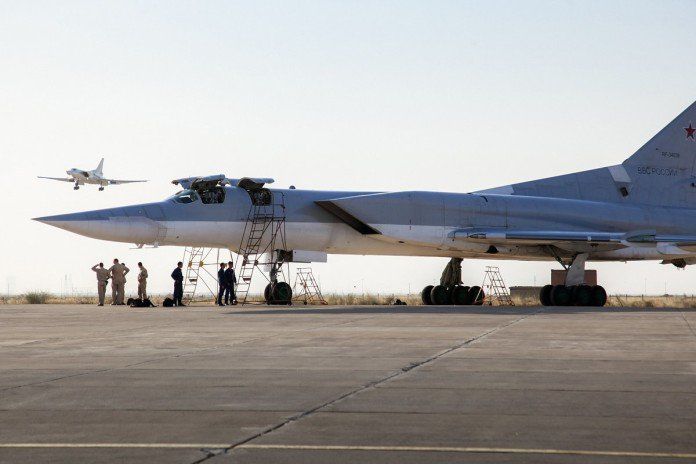FreeBeacon: Russia is building large numbers of underground nuclear command bunkers in the latest sign Moscow is moving ahead with a major strategic forces modernization program.
U.S. intelligence officials said construction has been underway for several years on “dozens” of underground bunkers in Moscow and around the country.
Disclosure of the underground command bunkers comes as Army Gen. Curtis Scaparrotti, commander of U.S. European Command, warned recently that Russia has adopted a nuclear use doctrine he called “alarming.”
“It is clear that Russia is modernizing its strategic forces,” Scaparrotti told a conference sponsored by the U.S. Strategic Command.
“Russian doctrine states that tactical nuclear weapons may be used in a conventional response scenario,” Scaparrotti said on July 27. “This is alarming and it underscores why our country’s nuclear forces and NATO’s continues to be a vital component of our deterrence.”
Mark Schneider, a former Pentagon nuclear policy official, said Russia’s new national security strategy, which was made public in December, discusses increasing civil defenses against nuclear attack, an indication Moscow is preparing for nuclear war.
“Russia is getting ready for a big war which they assume will go nuclear, with them launching the first attacks,” said Schneider, now with the National Institute for Public Policy, a Virginia-based think tank.
“We are not serious about preparing for a big war, much less a nuclear war,” he added.
Additionally, Russian officials have been issuing nuclear threats.
“A lot of things they say they are doing relate to nuclear threats and nuclear warfighting,” he said. “Active and passive defense were a major Soviet priority and [current Russian leaders] are Soviets in everything but name.”
Russia is engaged in a major buildup of strategic nuclear forces, building new missiles, submarines, and bombers. A State Department report on Russian activities under the New START arms treaty stated in the spring that Moscow added 153 strategic nuclear warheads to its arsenal under the treaty.
The increase in warheads is said to be the result of the deployment of new SS-27 Mod 2 intercontinental ballistic missiles with multiple warheads and SS-N-32 submarine-launched missiles.
In addition to new missiles, Russia is building a drone submarine, code-named “Kanyon,” which is said to be designed to carry a megaton-class warhead. Moscow also is moving ahead with a hypersonic strike vehicle designed to deliver nuclear warheads through advanced missile defense systems.
A report by the National Institute for Public Policy concludes that one reason for the Russian nuclear expansion is to sow fear of Moscow.
“Russian leaders appear to view nuclear weapons as the ultimate way to make the world ‘fear,’ or at least respect Russia, and provide a political lever to intimidate, coerce, and deter Western states from attempting to interfere militarily against Russian expansionism,” the report said.
Military analysts say possible U.S. responses to Russia’s underground nuclear complexes include the development of deep-penetrating nuclear bombs capable of placing Russia’s command structure at risk.
Another option proposed by nuclear experts is to develop low-yield nuclear arms that could be used in precision strikes.
Few details about the new nuclear underground bunkers were disclosed. State-run Russian press reports have said underground bunkers are being built in Moscow as part of the strategic forces buildup.
Russia’s Defense Ministry revealed in January that a modernized command and control system will be delivered to strategic forces this year.
The system was described by RIA-Novosti as a fifth-generation advanced command and control system.
Defense Ministry spokesman Maj. Dmitri Andreyev stated that the new system, known by its Russian acronym IASBU, will use digital signals to send combat orders and control strategic forces.
“The fifth-generation advanced integrated automated combat control system is being tested at industry enterprises,” Andreyev said, adding that by the end of the year missile units will be equipped with the “modernized control posts and advanced strategic missile systems under development with IASBU sections.”
The new system is being used with new SS-27 intercontinental missile units and will provide greater security so that orders will reach those units.
“This will enable use of missile systems without limiting distances while carrying out maneuvering and broadening of options in choosing their combat patrol routes,” the spokesman said.
The new underground nuclear facilities appear similar to earlier construction for command and control complexes during the Cold War, one official said. Russia also continued building underground nuclear facilities after the fall of the Soviet Union in 1991.
The CIA reported through classified channels in March 1997 that construction included an underground subway system from the residence of then-President Boris Yeltsin outside Moscow to a leadership command center.
“The underground construction appears larger than previously assessed,” a CIA report on the facilities stated. “Three decrees last year [1996] on an emergency planning authority under Yeltsin with oversight of underground facility construction suggest that the purpose of the Moscow-area projects is to maintain continuity of leadership during nuclear war.”
Construction work was underway on what the report described as a “nuclear-survivable, strategic command post at Kosvinsky Mountain,” located deep in the Ural Mountains about 850 miles east of Moscow.
Satellite photographs of Yamantau Mountain, also located about 850 miles east of Moscow in the Urals near the town of Beloretsk, revealed development of a “deep underground complex” and new construction at each of the site’s above-ground support areas. Yamantau Mountain means “Evil Mountain” in the local Bashkir language.
“The command post at Kosvinsky appears to provide the Russians with the means to retaliate against a nuclear attack,” the CIA report said, adding that the Russians were building or renovating four complexes within Moscow that would be used to house senior Russian government leaders during a nuclear conflict.
The CIA identified a bunker to be used by Russian leaders at Voronovo, about 46 miles south of Moscow. A second bunker located at Sharapovo, some 34 miles from Moscow, was equipped with a special subway running directly to it.
The nuclear war preparations are estimated to cost billions of dollars, and raise questions about past U.S. aid to Moscow that was aimed at helping secure Russian nuclear facilities.




